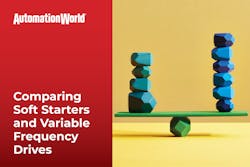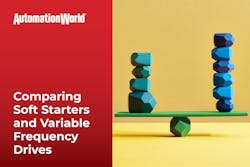Comparing Soft Starters and Variable Frequency Drives

Quick hits:
- Learn the 3 key differences between soft starters and VFDs
- Understand the energy and operating efficiency differences between soft starters and VFDs
- Find out which types of industrial applications are better for soft starters and which should use VFDs.
Related to this episode:
David Greenfield: Welcome to the Automation World Gets Your Questions Answered podcast, where we connect with industry experts to get the answers you need about industrial automation technologies.
Joining me to answer this question is Jacob Becker, system solution architect at system integrator Tri Tech Automation.
So there seems to be you know three big differences when you look at comparing soft starters and VFDs you know the first of which courses cost was soft starters being the cheaper option. Then there's the ability to control motor speed which VFDs offer but soft starters lack and then there's performance parameters and tuning capabilities both of which have more options on VFDs than soft starters. But beyond those main factors are there other key differences that users should be aware of when deciding between the two.
Jacob Becker: Sure. The first would be complexity. A VFD is a considerably more complex piece of equipment than what a soft starter is it has a lot more active components—IGBTs, capacitors, rectifiers, things of that nature. Um, since you know it has more active components like you mentioned there is additional cost. Um, there also is a size difference for a light for like motor size. A VFD is typically going to be fairly bigger than a than a soft starter. We all know that plant floor. Space is at a premium. So if you don't need a VFD a soft starter might be a great way to save some space and additionally some cost the next difference is heat like I mentioned there's a lot more active components in a VFD a VFD of equal size to a soft starter will put out considerably more heat than. Then a soft starter will because the components as we'll talk about later are always active on a VFD. So a lot of the a lot of the components that we need to worry about are around the installation of VFD so the size the heat additionally is cabling so with a VFD since we chop up that wave forming. Create that simulated square wave out on the out on the line. You can get a reflected wave back on the cabling so oftentimes a special cabling and then ah a line reactor is also recommended for long runs to prevent harmonics from being passed back onto the onto the power source. So if you have a lot of VFDs with long runs you run the risk of getting harmonic distortion on your on your power source and that can affect other equipment in the plant, especially sensitive equipment like instrumentation or PLCs.
David Greenfield: And I imagine would that also have an impact on the type of enclosure that you choose based on that as well.
Jacob Becker: Absolutely its going to make your enclosure a lot bigger and then it's going to come back to space and yeah VFDs take up quite a bit more space.
David Greenfield: With more manufacturers looking to make their operations more sustainable and reduce energy costs, overall efficiency would be an important consideration when making this is the decision between a soft starter or a VFD. I mean on the one hand you have the ability with a VFD to control motor speeds which can have a significant impact on efficiencies and costs. But soft starters also help reduce motor energy use and looking at the overall operation of the two devices soft starters often edge out the VFDs in terms of operating efficiency though just by a couple of percentage points. So considering all these issues, which one is likely to be the more efficient energy choice overall.
Jacob Becker: Sure That's ah, that's a great question and like a lot of questions and in engineering, it kind of depends — it all comes down to an application standpoint if you have a motor that you know you're going to start up and you want to start it up in a controlled fashion but it is going to run at a fixed speed all the time. The soft starter is the clear answer simply due to the fact that a lot of soft starters have bypass contactors either inside them or they will be added externally so that means once the motor is up to Speed. We shut off the we will energize the bypass contactor and then the soft starter. Components will actually shut down and not use any power. So There's no efficiency loss. There. The only time they're active is during the startup and potentially depending on application. The shutdown of that motor now a VFD would be more efficient in an instance where you might be able to start up a motor and run it at full speed for a period of time. But during a low load application. You still need to run it but you can reduce the speed of that motor say for a fan or a pump during a low-load application but you still need those devices to run you could slow them down and that would be a more energy efficient standpoint. But if you need to start it up and run it at full speed—60 hertz—all the time, the VFD will be constantly active, the IGBTs, the filters, everything is active and that that draws some power and will make them slightly less efficient though. They're both—Both devices are extremely efficient as far as as equipment goes.
